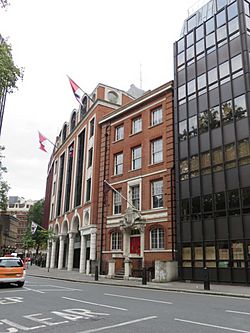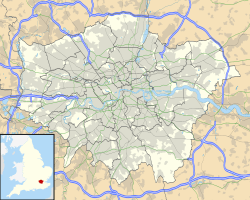Buckingham Gate drill halls facts for kids
Quick facts for kids Buckingham Gate drill halls |
|
|---|---|
| London | |

58 (centre) and 59 (beyond) Buckingham Gate
|
|
|
Location within London
|
|
| Coordinates | 51°29′53″N 0°08′11″W / 51.49815°N 0.13641°W |
| Type | Drill halls |
| Site history | |
| Built | 1886 |
| Built for | War Office |
| In use | 1886-Present |
The Buckingham Gate drill halls were two important military buildings. They were located at 58 and 59 Buckingham Gate in London. A drill hall is a place where soldiers train and practice their drills.
History of the Drill Halls
These buildings have a long and interesting history. They were used by different army groups over many years.
58 Buckingham Gate: A Training Hub
This building was finished in 1886. It was designed to be the main base for a group called the 13th Middlesex (Queen's Westminster) Volunteer Rifle Corps. This was a group of people who volunteered to train as soldiers.
In 1908, this group changed its name. It became the 16th (County of London) Battalion, London Regiment (Queen's Westminster Rifles). When World War I started in August 1914, the soldiers were called up for duty from this drill hall. They were then sent to the Western Front to fight.
Later, in 1937, the unit changed its name again. It was called the Queen's Westminsters, King's Royal Rifle Corps. In 1961, this regiment joined with another group. They then moved out of the drill hall to the Davies Street drill hall.
In the 1970s, the building was used by the Army Cadet Force Association. This is a youth organization linked to the army. Later, the Metropolitan Police Service used it a lot. Today, the building is still standing. It is used as a place for meetings and conferences.
59 Buckingham Gate: A Place for Sports and Inquiries
This building was also finished in 1886. It was designed by an architect named John Macvicar Anderson. The Duke of Cambridge, a member of the royal family, officially opened it in July 1886. It became the headquarters for the 7th (London Scottish) Middlesex Volunteer Rifle Corps.
This drill hall was quite famous for other events too. From 1899 to 1901, the All England Open Badminton Championships were held there. Imagine playing badminton in a military drill hall!
In May 1912, something very important happened here. The drill hall was used for the official investigation. This was the inquiry into the sinking of RMS Titanic. People wanted to find out why the famous ship sank.
Like the other drill hall, this one was also used for soldiers. In August 1914, the 14th (County of London) Battalion was called up for duty here. They also went to the Western Front during World War I. In 1937, this unit was renamed The London Scottish, The Gordon Highlanders.
During World War II in April 1944, Princess Elizabeth visited the drill hall. She came to see an exhibition by the Sea Scouts. In 1947, the regiment was reformed. Its main office stayed at this drill hall.
Sadly, this drill hall was torn down in 1985. Some parts of the building were saved. These included the iron roof and war memorials. They were moved to the new Horseferry Road drill hall. The area where the drill hall once stood is now used for office buildings.


